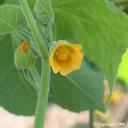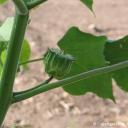Velvetleaf



Velvetleaf (Abutilon theophrasti Medicus)
Life cycle:
Summer annual. Emerges in the spring sets seed in late summer/fall and dies.
Emergence:
Velvetleaf starts emerging early in the spring, between 150 and 300 GDD (base 48 F); 25% emergence by 250 GDD (base 50 F). Velvetleaf continues to emerge throughout May and June.
Velvetleaf emerges from soil depths of up to 2 inches. If seed germinates on the soil surface, it dies. Therefore, leaving seed lying on the soil surface reduces survival.
Seed:
Production Average: Velvetleaf produces 2,000 to 9,000 seeds per plant. Plants produce about 70 to 200 seed capsules per plant, and each capsule contains 35-45 seeds.
Dispersal Mechanisms: None.
Longevity: Velvetleaf has limited persistence in the upper portion of the soil profile because it takes only 2 years for the seedbank to be reduced by 50% and about 16 years to deplete it by 99%. However, when velvetleaf seed is buried deep in the soil profile by plowing, the seed persists longer.
Dormancy: Velvetleaf dormancy is greater deeper in the soil profile.
Competitiveness:
Velvetleaf is a very competitive weed. If left uncontrolled in corn, yields can be reduced by 20-34% (3 velvetleaf plants per foot of corn row).
Preferred Soil / Field Conditions:
This weed prefers rich soils, high in nitrogen. It grows well on compacted soils and those with high pH.
Management:
Biological
Predation: The velvetleaf seed beetle lays eggs in developing seeds. By the time the velvetleaf seeds fall to the soil surface, 12 to 30% of the seeds have been destroyed by this insect. Once the seed falls to the ground, it is eatten by mice and insects (e.g. some species of carabid beetles). Velvetleaf seed is not a preferred food source of insects because it is larger than lambsquarters and pigweed seeds.
Decay: Velvetleaf seed coats have fungal associations that appear to protect the seed from other decay organisms in the field. However, once the seed coat is compromised, decay is rapid.
Mechanical
Tillage: Night tillage has no effect on velvetleaf emergence. Velvetleaf becomes less of a problem in no-till systems because the seed germinates on the soil surface and the seedlings do not survive.
Rotary hoeing: Hoeing is successful if the velvetleaf plants are less then 1/4" in height. Because velvetleaf can emerge from a 2" depth in the soil profile, it is difficult to remove with a rotary hoe once it is established.
Flaming: Flaming is effective on small velvetleaf plants.
Cultural
Crop rotation: Velvetleaf is not problematic in small grains or forages.
Planting date: Tilling in he spring triggers velvetleaf to germinate. However, velvetleaf continues to germinate for 8 to 10 weeks. Because of the extended time of emergence, planting early or planting late to redice velvetleaf infestations may not be effective.
Chemical
Application timing and effectiveness: Herbicides are available to control velvetleaf. Because velvetleaf emerges early, it is one of the weeds that must be watched so it does not exceed the maximum height for postemergence weed control.



 Print
Print Email
Email